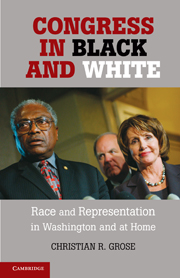Book contents
- Frontmatter
- Contents
- List of Figures and Tables
- Acknowledgments
- 1 African-American Legislators, African-American Districts, or Democrats?
- 2 A Unified Theory of African-American Representation in Congress
- 3 The “Hollow Hope” of Civil Rights Change in the U.S. House
- 4 Location, Location, Location
- 5 Constituency Service in the District
- 6 Bringing Home the Bacon
- 7 The Future of Racial Redistricting
- Appendix 1 Methods Used to Measure the Civil Rights Issue Space
- Appendix 2 Methods for Qualitative Research
- Appendix 3 Data, Methods, and Models for Project Allocations to African Americans
- References
- Index
7 - The Future of Racial Redistricting
Black-Decisive Districts
Published online by Cambridge University Press: 03 May 2011
- Frontmatter
- Contents
- List of Figures and Tables
- Acknowledgments
- 1 African-American Legislators, African-American Districts, or Democrats?
- 2 A Unified Theory of African-American Representation in Congress
- 3 The “Hollow Hope” of Civil Rights Change in the U.S. House
- 4 Location, Location, Location
- 5 Constituency Service in the District
- 6 Bringing Home the Bacon
- 7 The Future of Racial Redistricting
- Appendix 1 Methods Used to Measure the Civil Rights Issue Space
- Appendix 2 Methods for Qualitative Research
- Appendix 3 Data, Methods, and Models for Project Allocations to African Americans
- References
- Index
Summary
“North Carolina should have 7 women, 3.5 African-Americans in the House based on the numbers. All are taxpayers, but you don't get the services. You get tired of it.”
–Tawana Wilson-Allen, staffer to Representative Mel Watt, also quoted at the opening of Chapter 1, arguing why her state needs descriptive representation in Congress.Race matters in Congress. The descriptive representation of African Americans in Congress leads to substantive legislative outcomes favoring black constituents. The outcomes in which descriptive representation matters, though, are not those that have typically been examined by scholars of African-American legislative representation. Based on this research, a number of policy implications and other questions now present themselves. In the remainder of this book, I will examine a few of these. First, I will detail how this research fits in specifically with the major works in the research area of minority congressional representation detailed in both Chapters 1 and 2, focusing particularly on Carol Swain (1995), David Canon (1999), Katherine Tate (2003), and Kenny Whitby (1997) as they have also examined congressional behavior other than roll-call voting. Second, I will consider the aggregate implications of these findings, offering possible advice for the “best” districting arrangement for maximizing the substantive representation of black constituents. These aggregate implications include my recommendation to the courts and policy makers to draw black-decisive districts. Black-decisive districts are (1) districts that are electorally competitive; (2) districts in which black voters are likely to be decisive in electing the winner; and (3) districts that are likely to elect African-American legislators.
- Type
- Chapter
- Information
- Congress in Black and WhiteRace and Representation in Washington and at Home, pp. 167 - 186Publisher: Cambridge University PressPrint publication year: 2011



